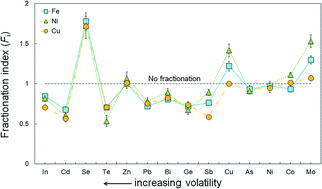当前位置:
X-MOL 学术
›
J. Anal. At. Spectrom.
›
论文详情
Our official English website, www.x-mol.net, welcomes your
feedback! (Note: you will need to create a separate account there.)
Addressing matrix effects for 193 nm excimer LA-ICP-MS analyses of Fe-rich sulfides and a new predictive model
Journal of Analytical Atomic Spectrometry ( IF 3.1 ) Pub Date : 2020/01/08 , DOI: 10.1039/c9ja00391f E. S. Steenstra 1, 2, 3, 4, 5 , J. Berndt 5, 6, 7 , S. Klemme 5, 6, 7 , W. van Westrenen 8, 9 , E. S. Bullock 1, 2, 3, 4 , A. Shahar 1, 2, 3, 4
Journal of Analytical Atomic Spectrometry ( IF 3.1 ) Pub Date : 2020/01/08 , DOI: 10.1039/c9ja00391f E. S. Steenstra 1, 2, 3, 4, 5 , J. Berndt 5, 6, 7 , S. Klemme 5, 6, 7 , W. van Westrenen 8, 9 , E. S. Bullock 1, 2, 3, 4 , A. Shahar 1, 2, 3, 4
Affiliation

|
Laser-ablation inductively coupled plasma mass spectrometry (LA-ICP-MS) is one of the most popular techniques for determining trace element concentrations in sulfides. Due to the lack of matrix-matched standards, standardization of sulfide analyses are usually based on silicate glass calibrant materials. Matrix effects during ns-LA-ICP-MS analyses of Fe-rich sulfides were quantified for many trace elements by comparison of elemental concentrations obtained by LA-ICP-MS and electron microprobe (EPMA) for many synthetic sulfides. The data was used to obtain the fractionation indices (Fi, the ratio between the EPMA- and LA-ICP-MS-determined concentrations of element i) for many elements while considering Fe, Cu and Ni as internal standards. The results show that significant (>15% RD) matrix effects arise during ns-LA-ICP-MS analyses of Ti, Zn, Ge, Se, Mo, Cd, In, Sb, Te, Pb, Bi in sulfides when using Fe as the internal standard. The use of Ni as an internal standard yields on average higher Fi values for most elements, resulting in more pronounced matrix effects for refractory elements and less so for volatile elements, relative to Fe. The use of Cu as an internal standard yields overall more significant matrix effects for volatile elements (i.e., lower Fi values). The Fi values for most elements remain constant with increasing concentrations, and matrix correction factors for these elements can therefore be applied across the ppm to wt% range. In agreement with previous observations for Fe-rich metals and silicate glasses, the magnitudes of the matrix effects for the various elements are strongly correlated with elemental volatility. This correlation was used to obtain a predictive model for describing Fi for Fe-rich sulfides. The results were used to assess the effects of matrix effects on calculated sulfide liquid–silicate melt partition coefficients derived from experiments. Matrix effects arising through the use of non-matrix-matched standards will result in significant discrepancies between measured and true partition coefficients, the extent mainly depending of the volatility of the element considered. Corrections on ns-LA-ICP-MS derived element concentrations therefore need to be performed to obtain true abundances in the absence of matrix-matched standards.
中文翻译:

解决富铁硫化物在193 nm准分子LA-ICP-MS分析中的基质效应和新的预测模型
激光烧蚀电感耦合等离子体质谱法(LA-ICP-MS)是测定硫化物中痕量元素浓度的最流行技术之一。由于缺乏与基质匹配的标准品,因此硫化物分析的标准化通常基于硅酸盐玻璃校准物材料。通过比较LA-ICP-MS和电子微探针(EPMA)获得的许多合成硫化物的元素浓度,可以对许多痕量元素进行ns-LA-ICP-MS分析富铁硫化物时的基质效应。该数据用于获得分馏指数(F i,由EPMA和LA-ICP-MS确定的许多元素的浓度i),同时将Fe,Cu和Ni作为内标。结果表明,当使用Fe进行ns-LA-ICP-MS分析硫化物中的Ti,Zn,Ge,Se,Mo,Cd,In,Sb,Te,Pb,Bi时,会产生显着(> 15%RD)的基质效应作为内部标准。使用Ni作为内标,大多数元素的F i值平均较高,相对于Fe,难熔元素的基质效应更为明显,而挥发性元素的基质效应则较小。使用铜作为内标对挥发性元素产生总体上更显着的基质效应(即较低的F i值)。该˚F我大多数元素的浓度值随浓度的增加而保持恒定,因此可以在ppm至wt%的范围内应用这些元素的基质校正因子。与先前对富铁金属和硅酸盐玻璃的观察结果一致,各种元素的基质效应大小与元素挥发性密切相关。这种相关性用于获得描述F i的预测模型用于富铁硫化物。结果被用来评估基体效应对实验得出的硫化物-硅酸盐熔体分配系数的影响。通过使用非矩阵匹配的标准品而产生的基质效应将导致实测分配系数与真实分配系数之间存在重大差异,其程度主要取决于所考虑元素的挥发性。因此,在没有基质匹配的标准品的情况下,需要对ns-LA-ICP-MS衍生的元素浓度进行校正,以获得真正的丰度。
更新日期:2020-03-12
中文翻译:

解决富铁硫化物在193 nm准分子LA-ICP-MS分析中的基质效应和新的预测模型
激光烧蚀电感耦合等离子体质谱法(LA-ICP-MS)是测定硫化物中痕量元素浓度的最流行技术之一。由于缺乏与基质匹配的标准品,因此硫化物分析的标准化通常基于硅酸盐玻璃校准物材料。通过比较LA-ICP-MS和电子微探针(EPMA)获得的许多合成硫化物的元素浓度,可以对许多痕量元素进行ns-LA-ICP-MS分析富铁硫化物时的基质效应。该数据用于获得分馏指数(F i,由EPMA和LA-ICP-MS确定的许多元素的浓度i),同时将Fe,Cu和Ni作为内标。结果表明,当使用Fe进行ns-LA-ICP-MS分析硫化物中的Ti,Zn,Ge,Se,Mo,Cd,In,Sb,Te,Pb,Bi时,会产生显着(> 15%RD)的基质效应作为内部标准。使用Ni作为内标,大多数元素的F i值平均较高,相对于Fe,难熔元素的基质效应更为明显,而挥发性元素的基质效应则较小。使用铜作为内标对挥发性元素产生总体上更显着的基质效应(即较低的F i值)。该˚F我大多数元素的浓度值随浓度的增加而保持恒定,因此可以在ppm至wt%的范围内应用这些元素的基质校正因子。与先前对富铁金属和硅酸盐玻璃的观察结果一致,各种元素的基质效应大小与元素挥发性密切相关。这种相关性用于获得描述F i的预测模型用于富铁硫化物。结果被用来评估基体效应对实验得出的硫化物-硅酸盐熔体分配系数的影响。通过使用非矩阵匹配的标准品而产生的基质效应将导致实测分配系数与真实分配系数之间存在重大差异,其程度主要取决于所考虑元素的挥发性。因此,在没有基质匹配的标准品的情况下,需要对ns-LA-ICP-MS衍生的元素浓度进行校正,以获得真正的丰度。











































 京公网安备 11010802027423号
京公网安备 11010802027423号